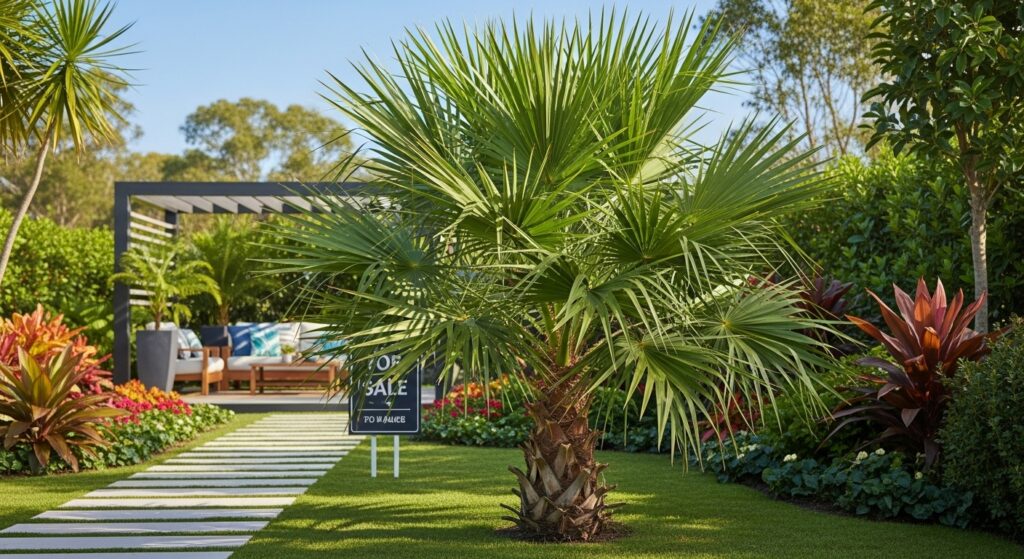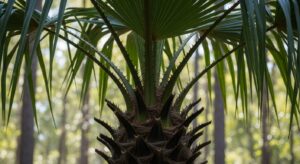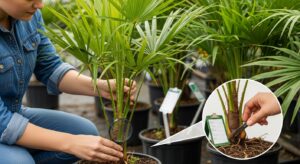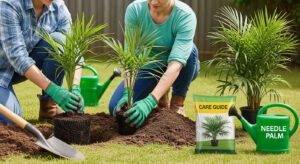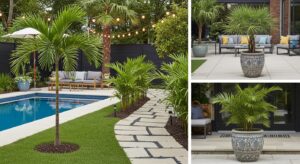Introduction
The Needle Palm Tree, or Rhapidophyllum hystrix as it is called, comes from the southeastern United States. This unusual palm stands out because it can handle cold weather and still stay strong, which makes it a favorite for both gardeners and landscapers. Most palms struggle in colder areas, but the Needle Palm grows well in USDA zones 6 to 10. This wide range adds to its popularity.
The Needle Palm Tree, with its fan-like leaves and sharp, needle-shaped spines, adds a bold look to any yard or garden. Its slow-growing nature and smaller size make it a top pick to bring a tropical vibe to tight spaces. This tree stands strong against tough weather and common garden pests, making it a lasting choice for outdoor spaces. Adding a Needle Palm Tree to your yard gives you the tropical feel of a palm without the usual hassle they bring. Whether you’re experienced in gardening or just starting, this tree combines ease of care with an eye-catching appearance.
Native to the southeastern United States, this palm holds up well in a variety of climates, adding to its charm.
- Tropical Style: Brings a touch of the exotic without much effort.
- Flexible Purpose: Works well for beginner and seasoned gardeners alike.
What Makes the Needle Palm Tree Unique
The Needle Palm Tree stands out because of a few important features that make it different from other types of palms. Its trunk stays hidden under thick bunches of sharp, needle-like spines that can reach up to eight inches in length. These spines don’t just look distinct; they also act as a natural way to keep animals away.
The palm’s leaves stand out with their fan-like shape and dark green color. They stay rich in color all year round and grow up to three feet long. This growth gives the tree its thick, full look. Although the Needle Palm stays small, reaching just 4 to 6 feet in height, its striking leaves make it impressive.
The Needle Palm Tree does more than just look good. It is tough enough to handle temperatures as low as -5°F (-20°C). This makes it one of the hardiest palm trees around. Its ability to adapt means it grows well in different spots, whether in sunny coastal places or shaded gardens in the woods.
- Sharp Spines: Long, thin spines reaching up to eight inches shield the trunk.
- Lush Leaves: Fan-shaped, deep green leaves can grow as long as three feet.
- Handles Cold: Withstands temperatures down to -5°F, making it suitable to grow in different climates.
Why You Should Own a Needle Palm Tree
Having a Needle Palm Tree offers many perks that beautify and improve your Garden. A major advantage is how little care it needs. Unlike many other palms that require specific conditions, this tree adjusts well to different soils and moisture, so it does not need constant attention.
The Needle Palm Tree makes a smart investment because it lasts a long time and handles tough conditions well. After it settles in, you need to water it, and pests don’t bother it. This means you can enjoy how it looks without spending too much time taking care of it. Since it stays strong in cold weather, you can keep it outside all year in many places.
The Needle Palm also works great in landscaping projects. You can use it in many ways, such as a garden centerpiece, in borders, or in tropical-themed setups. Its unique look fits lots of different styles. When you combine its toughness with its flexibility, it becomes a great choice to increase a property’s appeal.
- Easy to care for: Handles different soil types and requires little attention.
- Durable Choice: Offers pest resistance and stays tough to remain a solid investment over time.
- Flexible Look: Works well with many styles of landscaping, whether used as a centerpiece or along borders.
Where to Buy Needle Palm Trees
You can buy Needle Palm Trees if you know good places to search. Many garden centers and local nurseries carry these trees in areas where they grow well. Visiting these spots lets you see the trees up close and talk with staff who can share tips about caring for them.
Online stores make it easy to buy Needle Palm Trees. Many websites specialize in different types of palms, including Needle Palms, and they can deliver them to your home. Shopping online lets you check prices from different sellers and read reviews from other buyers to get the best deal.
When you decide to buy a Needle Palm Tree, think about how big and developed the tree is. Bigger and more grown plants cost more, but add an instant effect to your garden. On the other hand, younger trees are cheaper and can be satisfying to grow and care for as they develop over time.
- Local Nurseries: Let you pick in person and talk to experts for advice.
- Online Retailers: Offer convenience with more options and reviews from other shoppers.
- Size Choices: Pick mature trees to create a striking impression or go with younger ones to save money.
How to Pick a Needle Palm Tree
To pick the right Needle Palm Tree, think about a few key factors. Look at your planting area’s conditions like how much sunlight it gets, the kind of soil it has, and how much wind it deals with. This will help you figure out the right size and maturity of the tree for your space.
Also, think about what purpose the tree will serve in your garden. To make it a standout feature, choose a bigger tree that draws attention. If you want it to blend with other plants or fit into a mix of palms, younger or smaller ones might work better.
When you buy a tree, check its health. Look for healthy leaves, a strong trunk, and no pests or disease. Good sellers share details about the tree’s growth and care needs. With this info, you can pick a Needle Palm Tree that adds to your garden.
To summarize:
- Evaluate the spot where you’ll plant the tree. Consider how much sun, wind, and what kind of soil the area gets.
- Think about how the tree fits your design. Larger trees work well as main highlights, while smaller ones look nice at edges.
- Always check the tree’s condition. Look for lively leaves and ensure they’re free from pests and illnesses.
Steps to Plant and Take Care of Your Needle Palm Tree
Taking care of and planting your Needle Palm Tree plays a big role in how well it grows. Start by picking a spot with soil that drains water well and gets at least some sunlight, if not plenty. While this palm can adjust to various conditions, it grows best in soil with a bit of acidity. You might want to check and improve the soil if needed.
To plant the tree, dig a hole that is twice as wide as the root ball but not deeper. This space lets the roots spread. Make sure to give the tree a good soak after putting it in the ground. This helps the roots settle in firmly. In the first year, make sure the soil stays evenly moist without drowning the roots, as too much water can cause the roots to rot.
Regular care involves using mulch to keep the soil moist and adding a fertilizer made for palms during the growing season. Trimming is pretty straightforward and just means cutting off leaves that are dead or damaged. Stick to these steps, and your Needle Palm Tree will thrive while making your garden more attractive.
- Best Spot: Pick soil that drains well, is acidic, and gets plenty of sunlight.
- Planting Done Right: Dig a wide hole and give it plenty of water to help the roots grow.
- Easy Upkeep: Use mulch, add fertilizer, and do light pruning to keep it healthy.
Troubles with Needle Palm Trees and Ways to Fix Them
Needle Palm Trees are tough, as they sometimes need a little care to stay healthy. Yellowing leaves point to problems like a lack of nutrients or watering mistakes. Fix this by changing how often you water and using a balanced fertilizer to help the tree bounce back.
Pests don’t give Needle Palms much trouble, but scale insects or spider mites might show up now and then. Checking the plant often and using insecticidal soap or horticultural oil can handle these pests and keep the plant safe.
Root rot can show up when the soil does not drain properly. Plant your palm in a spot with good drainage to avoid this. Also, do not give it too much water. If you think your tree might have root rot, fix the drainage and cut back on watering to help it bounce back. Tackling these problems keeps your Needle Palm Tree healthy and strong.
- Leaves Turning Yellow: Water the tree and add some fertilizer to deal with missing nutrients.
- Dealing With Pests: Treat spider mites or scale insects by applying insecticidal soap.
- Stop Root Rot: Make sure water drains well so the soil does not stay soggy.
Comparing Needle Palm Trees with Other Palm Varieties
When you line up Needle Palm Trees beside other palms, a few clear traits jump out. Unlike the lofty coconut or date palms, the Needle stays short, so it tucks nicely into tiny yards, rooftop gardens or even patio pots. Plus, its cold-hardiness lets it brave zones where other palms simply give up on winter. The most obvious trait is its crown of needle-like spines that climb the trunk, giving hungry critters second thoughts.
Meanwhile, many smooth-barked palms offer no built-in armor at all, leaving their trunks open to nibbling deer or bored rodents. Those spikes not only draw admiring glances but also boost the tree’s long-term toughness. In everyday care, the Needle proves easier than fussy Areca or Majesty palms.
It shrugs off pests, eats almost any soil mix, and seldom asks for fertilizer, so if you want to add a tropical aesthetic to your garden with little fuss, you should consider it.
- Compact Size: Tucks into tight spots; no height war with coconut or date palms.
- Spiny Trunk: Nature’s barbed-wire guard, plus an eye-catching twist.
- Low Maintenance: Shrugs off pests and poor soil, unlike picky Areca or Majesty types.
Decorative Uses for Needle Palm Trees in Landscaping
Needle palm trees can be used decoratively in landscaping. Because of their unique look, needle palm trees can be used for a variety of decorative landscaping purposes. They are a great option for creating a tropical oasis in urban gardens or small spaces because of their lush foliage and compact size. They are eye-catching and give depth to your landscape design when planted as a stand-alone feature.
Needle palms can be used to create layered planting schemes in larger gardens. Texture and diversity can be added by pairing them with flowering shrubs or taller palm varieties. Additionally, their dark green leaves make a striking contrast to vibrant perennials and annuals in mixed borders.
Use Needle Palms as foundation plantings around your house for a more organized look. They can soften the lines of buildings or walkways and add interest throughout the year due to their evergreen nature.
Needle palms add a special charm to any garden setting, whether they are used as a focal point or as a complementary element.
- Tropical Oasis: An excellent stand-alone feature for tiny or city gardens.
- Layered Designs: For texture, go well with taller shrubs or palms.
- Foundation planting: Provides year-round evergreen appeal while softening structures.
Conclusion:
Appreciating the Needle Palm Tree’s Distinct Beauty. Including the needle palm tree in your garden gives you the chance to take advantage of a special fusion of resilience, beauty, and usefulness. It is a great option for both gardeners and landscapers due to its adaptability to different climates and low maintenance needs.
You can safely add this gorgeous tree to your outdoor or rooftop area if you are aware of its traits and maintenance requirements. The advantages are obvious whether you’re buying your first needle Palm Tree or expanding your collection.
This palm offers an amazing way to improve your landscape because of its eye-catching appearance and versatility. Your needle palm tree will continue to be beautiful and enjoyable for many years to come with the proper maintenance.
Ready to transform your garden with the unique elegance of a Needle Palm Tree?
Contact us for expert advice and assistance in choosing the right tree for your needs. Let’s bring the beauty of the tropics to your doorstep!

